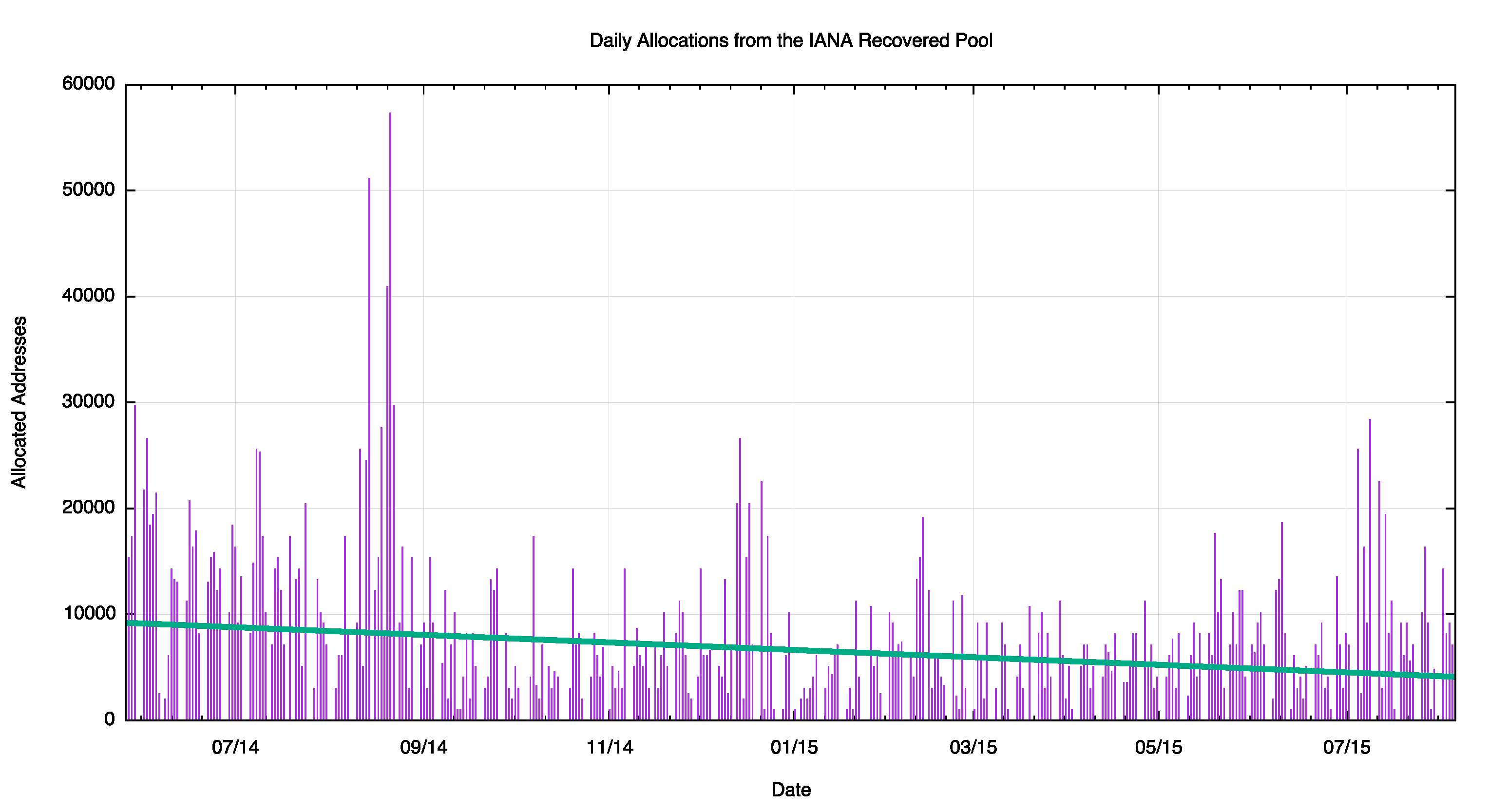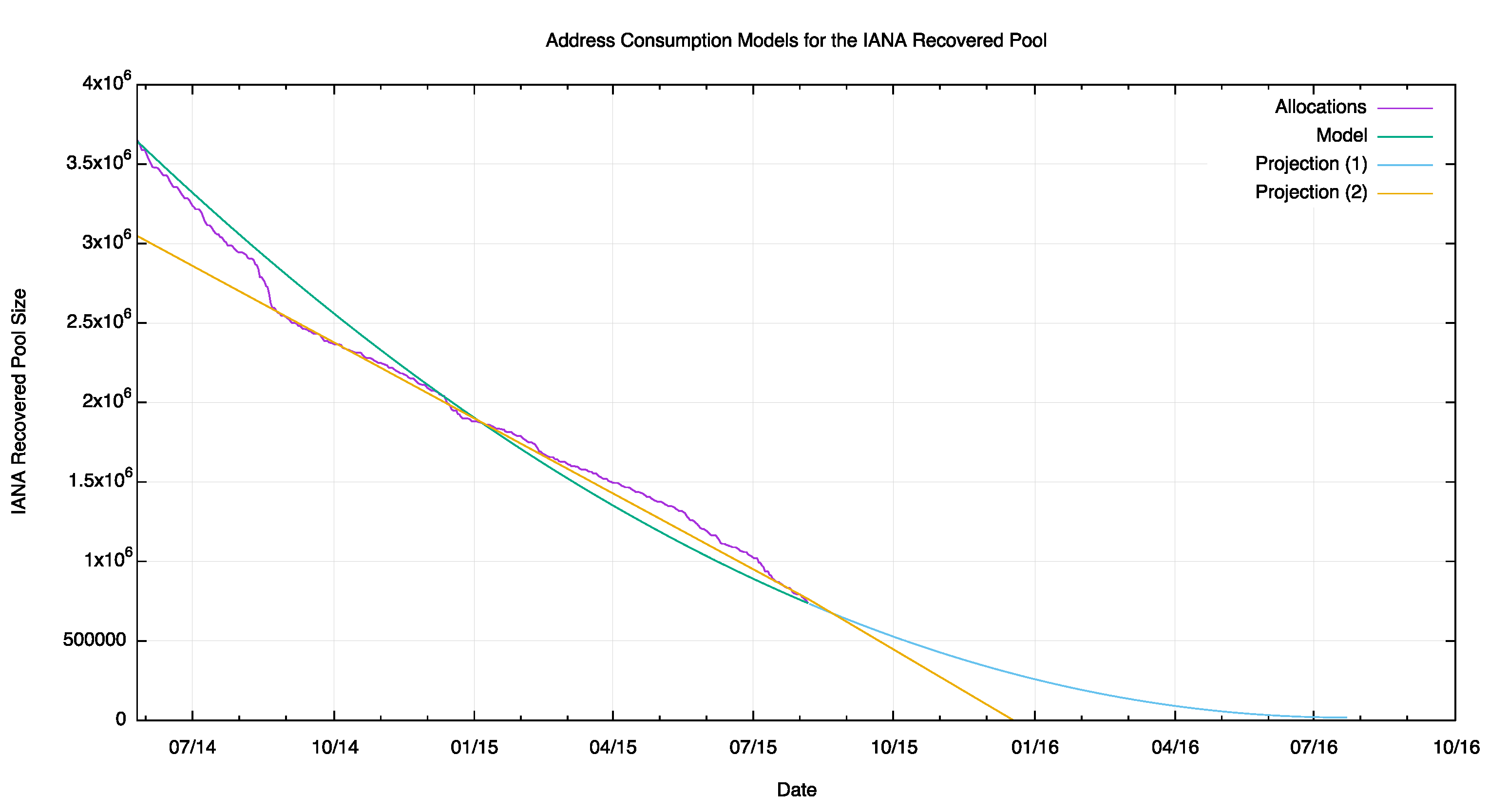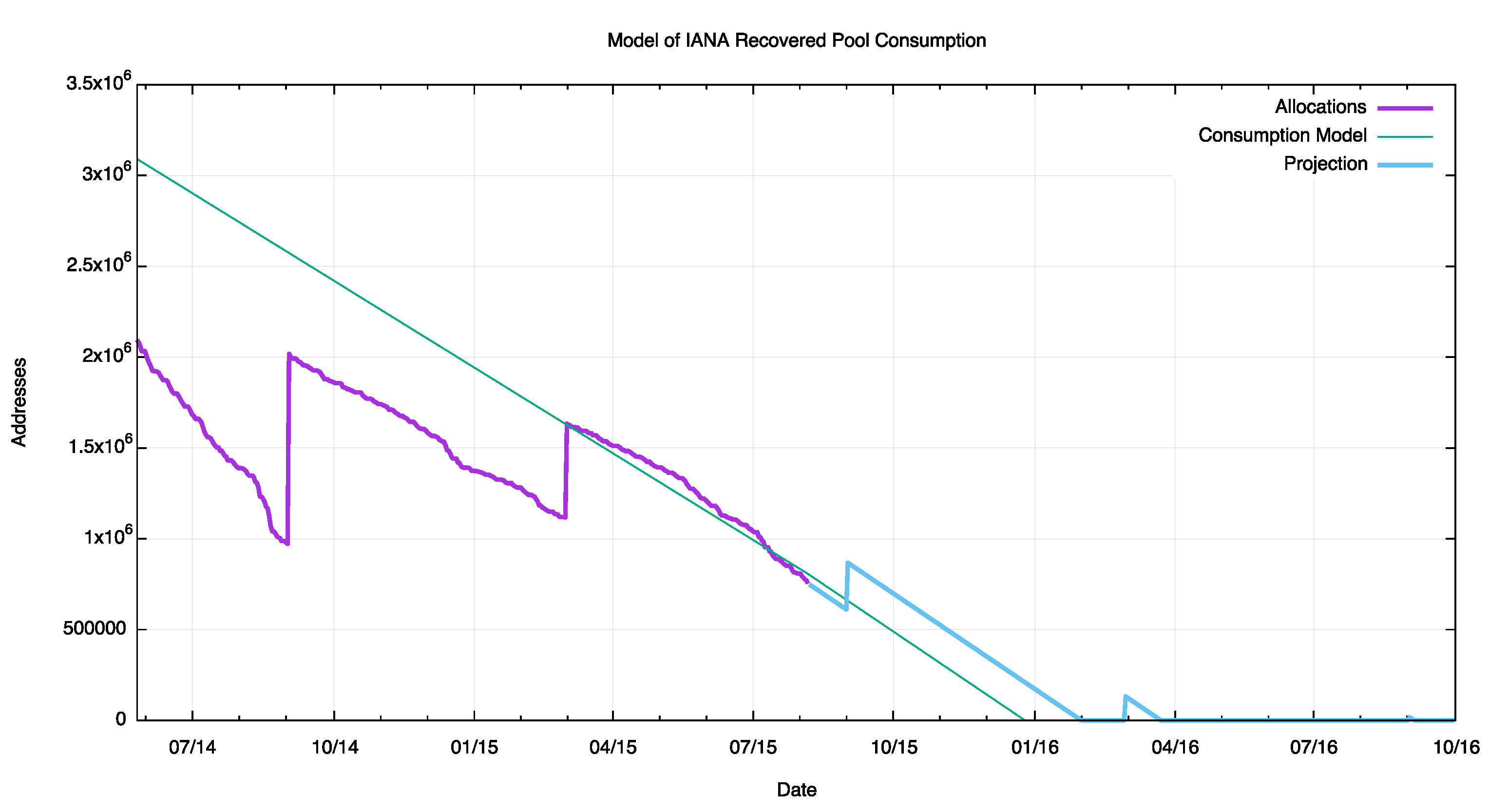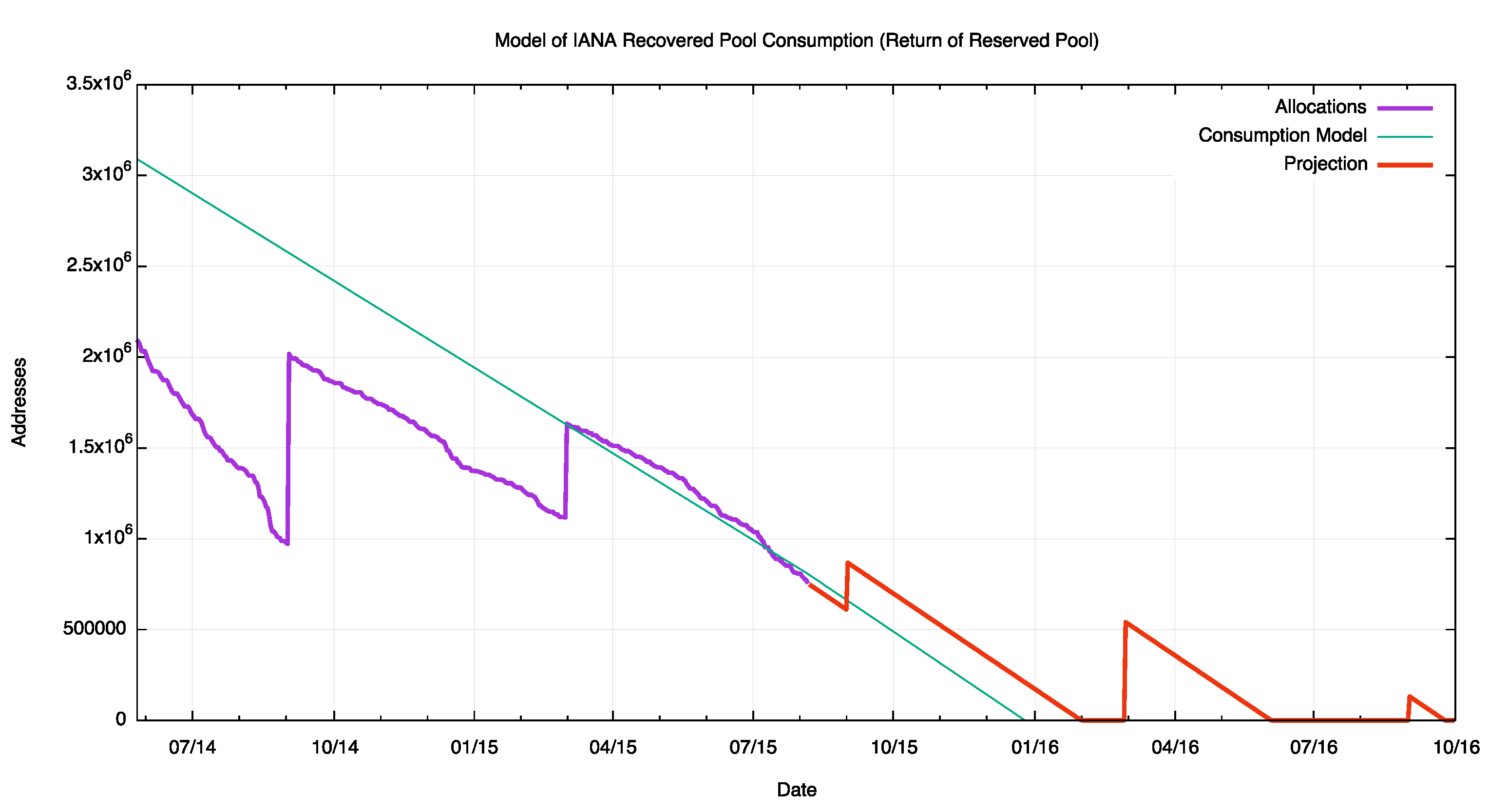It has been said often enough that its easy to make predictions; the tough part is getting them right! And in trying to predict the manner that APNIC will exhaust its remaining supply of IPv4 addresses I’m pretty sure that I did not get it right in the most recent article on this topic. So I’ll try and correct that in a more detailed look at the situation.
A Simple Exhaustion Model
Let’s look at what the oracle bones had been saying. This is the picture of the consumption of IPv4 addresses in APNIC since the start of 2013.

Figure 1 – APNIC Projected consumption of remaining available IPv4 addresses
The blue line in Figure 1 tracks the consumption of IPv4 addresses as they are allocated by APNIC to end entities. In 2013 some 1,257,904 addresses were allocated by APNIC, and the actual monthly allocation rate was relatively consistent with the average of 106,000 addresses per month. However, there was a change in the address consumption rate in late May 2014, and the overall address consumption rate tripled. After three months the consumption rate slowed down somewhat to a steady state that was approximately double the 2013 address consumption rate.
APNIC is now allocating an average of some 13,500 addresses per day. There are some 11,054,592 addresses marked as “available†in the APNIC registry, so this pool will last a further 818 working days, or 3.2 years. If we also take into account a steady increase in the address allocation rate at an average rate of increase of an additional 8 addresses per day then we get to 2.5 years if we continue allocations in future years at the same rates as we have observed in the middle of 2014. There may well be some element of rush on the registry as the address pool dwindles, so the prediction I made was that APNIC had some 2 to 2½ years to go in IPv4.
All well and good, but unfortunately it’s wrong.
APNIC’s Address Pools
There are four pools of addresses held by APNIC:
- “available†and “reserved†addresses in the last /8, 103.0.0.0/8: 10,629,888 addresses (out of a total of 16,777,216 addresses).
- “available†and “reserved†addresses in the set of legacy IPv4 addresses that have been returned to IANA and subsequently re-assigned to APNIC: 753,664 addresses (out of a total of 3,670,016 addresses).
- “reserved†addresses that are held by APNIC, based on withdrawal of registration from non-contactable holders from previous legacy allocations that were subsequently transferred to APNIC: 2,685,696 addresses (out of a total of 51,817,728 addresses.
- “reserved†addresses that are held by APNIC, based on withdrawal of registration from non-contactable holders from previous APNIC allocations: 1,596,928 addresses (out of a total of 803,663,616 addresses).
The status of each of these pools is shown in Table 1.
| Pool | Assigned | Available | Reserved | |
| Last /8 | 16,777,216 | 6,147,328 | 10,317,312 | 312,576 |
| IANA Returns | 3,670,016 | 2,916,352 | 737,280 | 16,384 |
| Various | 51,817,728 | 49,132,032 | 0 | 2,685,696 |
| APNIC Allocations | 803,663,616 | 802,066,688 | 0 | 1,596,928 |
| Total | 875,928,576 | 860,262,400 | 11,054,592 | 4,611,584 |
Table 1 – APNIC Address Pool status
The first pool, including the 10,629,888 available and reserved addresses, in the last /8 will be allocated according to the Last /8 policy:
https://www.apnic.net/policy/resources, Section 6.1
“Since Friday, 15 April; 2011, each APNIC account holder is only eligible to receive IPv4 address delegations totaling a maximum /22 from the APNIC 103/8 IPv4 address pool. […] To receive delegations from [this pool], they must demonstrate their eligibility by meeting the criteria specified below.”
The second pool, including 753,664 available and reserved addresses operates under a the IANA recovered IPv4 pool address policy:
https://www.apnic.net/policy/resources, Section 6.1
“On Tuesday, 27 May 2014, each APNIC account holder became eligible to receive additional delegations up to a maximum of /22 address space from the APNIC non-103/8 IPv4 address pool. […] To receive delegations from [this pool], they must demonstrate their eligibility by meeting the criteria specified below.”
The third pool of 2,685,696 currently reserved addresses appears to be outside the scope of APNIC address allocation policies and presumably will be returned to the IANA as part of the IANA-managed recovered address pool. Parts of this pool would presumable be returned to APNIC (and other RIRs) as part of IANA’s distribution of recovered pool addresses.
The final address pool of 1,596,928 currently reserved addresses is evidently to be treated in the same manner as the IANA recovered IPv4 pool:
https://www.apnic.net/policy/resources, Section 6.1.1
“Address space returned to APNIC, or allocated to APNIC from the ‘IANA Recovered IPv4 Pool’ will be added to the non-103/8 IPv4 address pool. If address space in this pool becomes sufficient to delegate a further /22 to each APNIC account holder, additional delegation rounds will be announced.
In working through the exhaustion scenario for APNIC we need to model two address consumption models. The first is the consumption of the 10,629,888 addresses that remain in the last /8. The second is the consumption of the total of 2,350,592 currently available and reserved addresses, plus an anticipated additional 962,752 addresses, that will be allocated from IANA to APNIC as part of the operation of the IANA Recovered IPv4 address pool.
As these two models operate in parallel we can look at their anticipated operation independently.
Consumption of the Last /8
The daily record of the allocations from 103.0.0.0/8 is shown in Figure 2.

Figure 2 – APNIC allocations in 103.0.0.0/8
This figure also shows a least squares best fit to the allocation data, showing a linear growth in address consumption over the past four years.
There are two models can be used to project future levels of consumption of addresses from this pool.
The first is the model of an increasing consumption rate of addresses as given by the best fit to the data accumulated so far. This is a consumption rate of an average of 5,500 addresses allocated per day in mid 2015, rising by a constant 2.47 addresses per day. In four years time this equates to a rise in the address allocation rate of an average of 9,100 addresses per day.
The second model uses a constant consumption rate, taking the average daily address consumption rate in 2015 of 5,704 addresses per day, and projecting forward with that constant consumption rate.
The results of these models are shown in Figure 3.

Figure 3 – Projections of APNIC allocations in 103.0.0.0/8
The increasing consumption rate forecasts that the last /8 will last for a further 4 years, exhausting the pool in mid 2019 (Projection (1) in Figure 3). The constant consumption rate shows that exhaustion of this pool will occur at the end of the third quarter of 2020, or 5 years and 2 months from now (Projection (2) in Figure 3).
These models indicate that a reasonable exhaustion prediction of this address pool is between 4 and 5 years hence, or around the start of 2020.
Consumption of the IANA Return Pool
Lets look at the allocation rate from these address blocks (Figure 4).

Figure 4 –APNIC allocations from the Returned Address pool
The address allocation rate has declined over time, from an average of just under 10,000 addresses per day in May 2014, when allocations from this pool commenced, to 4,000 addresses per day in mid 2015. The average daily allocation in 2015 from this pool was 5,226 addresses.
We can use this data to generate a model of projected consumption of the remainder of the address pool, shown in Figure 5. Using a constant consumption model of projected allocations from this pool, the remaining 737,280 addresses will last until December 2015. The trend of decreasing allocations projects a longer anticipated lifetime for this address pool, as it projects that demand will taper off to zero before exhausting the pool. This is a somewhat unlikely scenario.

Figure 5 – Projections of APNIC allocations from the Returned Address pool (1)
A model of the consumption of this pool has to take into account the anticipated schedule of additional address allocations from IANA to APNIC. While the current pool size is 753,664 addresses, we need to add the anticipated schedule of the return of address space currently held by the IANA. At present, the current holdings in this IANA pool will generate the following schedule of address allocations to APNIC.
| Date | Block | Address Count | ||
| September 2015 | /14 | 262,144 | ||
| March 2016 | /15 | 131,072 | ||
| September 2016 | /18 | 16,384 | ||
| March 2017 | /19 | 8,192 | ||
| September 2017 | /20 | 4,096 | ||
| March 2018 | /21 | 2,048 | ||
| September 2018 | /22 | 1,024 | ||
| March 2019 | /23 | 512 | ||
| Total | 425,472 |
A slightly different model of this Returned Address pool is shown in Figure 6, showing both the previous and anticipated allocations made by the IANA to APNIC. The model used for the allocation projections is the constant consumption model of an average of 5,226 addresses per day, which appears to be a better fit to the recent (2015) consumption data.

Figure 6 – Projections of APNIC allocations from the Returned Address pool (2)
There are a number of additional IANA return allocations after 2016, but they are so small as to be insignificant when compared to the modelled average demand of some 5,226 addresses per day. Effectively this pool ceases to be useful for APNIC in early 2016, so the anticipated IANA allocations of additional addresses will extend the effective usefulness of this address pool by some 3 months.
Some Reserved Speculation
As shown in Table 1, the APNIC IPv4 address registry lists some 4,611,584 addresses as “reservedâ€.
There is a hypothetical question that can be asked: “If these reserved addresses were cleared to subsequent allocation, would it have any impact on the address exhaustion models for APNIC?†Of course this is hypothetical scenario, and its making an assumption that is perhaps impossible, namely that all of the various situations that have lead to addresses being marked as reserved can be appropriately resolved and the addresses can be cleared for subsequent allocation. So with the clear caveat that this is a speculative exercise, lets look at some numbers.
Of these reserved addresses, some 2,685,696 addresses are within the address blocks that are part of the pre-RIR so-called “legacy†space, where APNIC effectively inherited these registrations. The RIRs have decided to pass all recovered address space from these “legacy†address blocks back to IANA for subsequent re-allocation, but these reserved addresses are not the same as the previously recovered addresses.
In this hypothetical exercise, lets speculate with a scenario where APNIC returns all 2,685,696 addresses back to the IANA before the end of 2015. In this scenario, the future schedule of IANA allocations to APNIC would be altered to be as follows:
| Date | Block | Address Count | ||
| September 2015 | /14 | 262,144 | ||
| March 2016 | /13 | 524,288 | ||
| September 2016 | /15 | 131,072 | ||
| March 2017 | /17 | 32,768 | ||
| September 2017 | /19 | 8,192 | ||
| March 2018 | /20 | 4,096 | ||
| Total | 962,752 |
The result would be an additional 0.5M addresses passed back to APNIC from the IANA as part of its return process. This would allow a further 500 entities to obtain a /22 allocation from this pool. The March 2016 allocation would provide addresses for a further 4 months of operation of this pool, and the September allocations would provide for a further month of operation (Figure 7).

Figure 7 – Projections of APNIC allocations from the Returned Address pool (3)
There is another pool of reserved addresses comprising of a total 1,596,928 addresses marked as “reserved†within address blocks that IANA originally allocated to APNIC.
We can add to this hypothetical scenario an additional factor of the reassignment of the entire pool of 1,596,928 currently reserved addresses as being available. In this hypothetical scenario, if this were to take place by the end of 2015 then the model of the projected use of the Returned Address pool would be as shown in Figure 8. This scenario projects the effective life of this pool to March 2017 before it would be fully depleted.

Figure 8 – Projections of APNIC allocations from the Returned Address pool (4)
Of course these last two exercises in the re-use of the currently reserved space fall entirely into the realm of idle speculation. There are likely to be a diverse set of reasons why this address space is marked as “reserved†in the registry. It is equally likely that there may be cases why returning some reserved address blocks back into circulation for reassignment would not be a responsible or appropriate action for the registry, and other cases where it may be possible at some time in the future to remove the reservation tag, but not immediately. The simple status of “reserved†covers many situations, and the scenarios shown here are perhaps best left as exercises in numbers rather than as a prescription of a likely, or even possible, future.
Exhaustion
The final /8 in APNIC will last for a further 4 to 5 years, assuming the continuation of a demand model at a level commensurate with current demands. This pool is projected to be fully depleted some time between mid 2019 and mid 2020.
The IANA Recovered Address Pool will not last as long. At current demand levels the pool will last until early 2016, or some 6 months from now.
What’s the message?
If we are talking IPv4 then it’s over.
It’s time to get serious about IPv6.